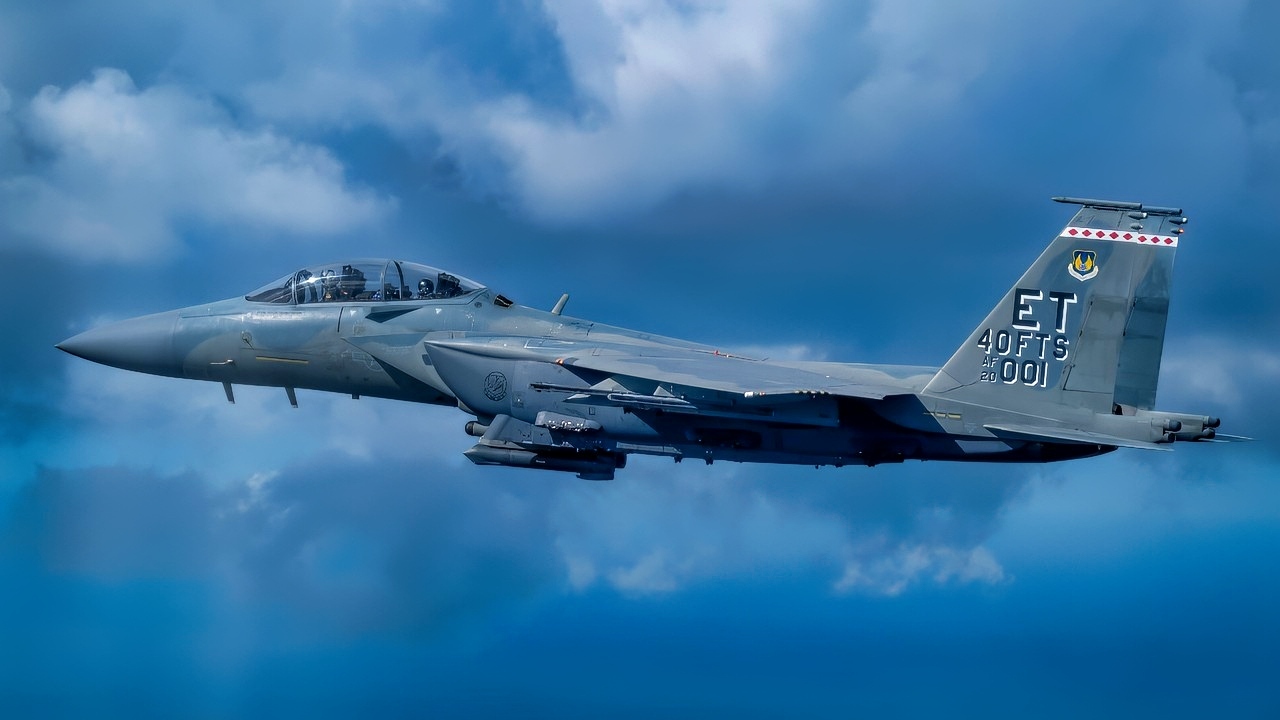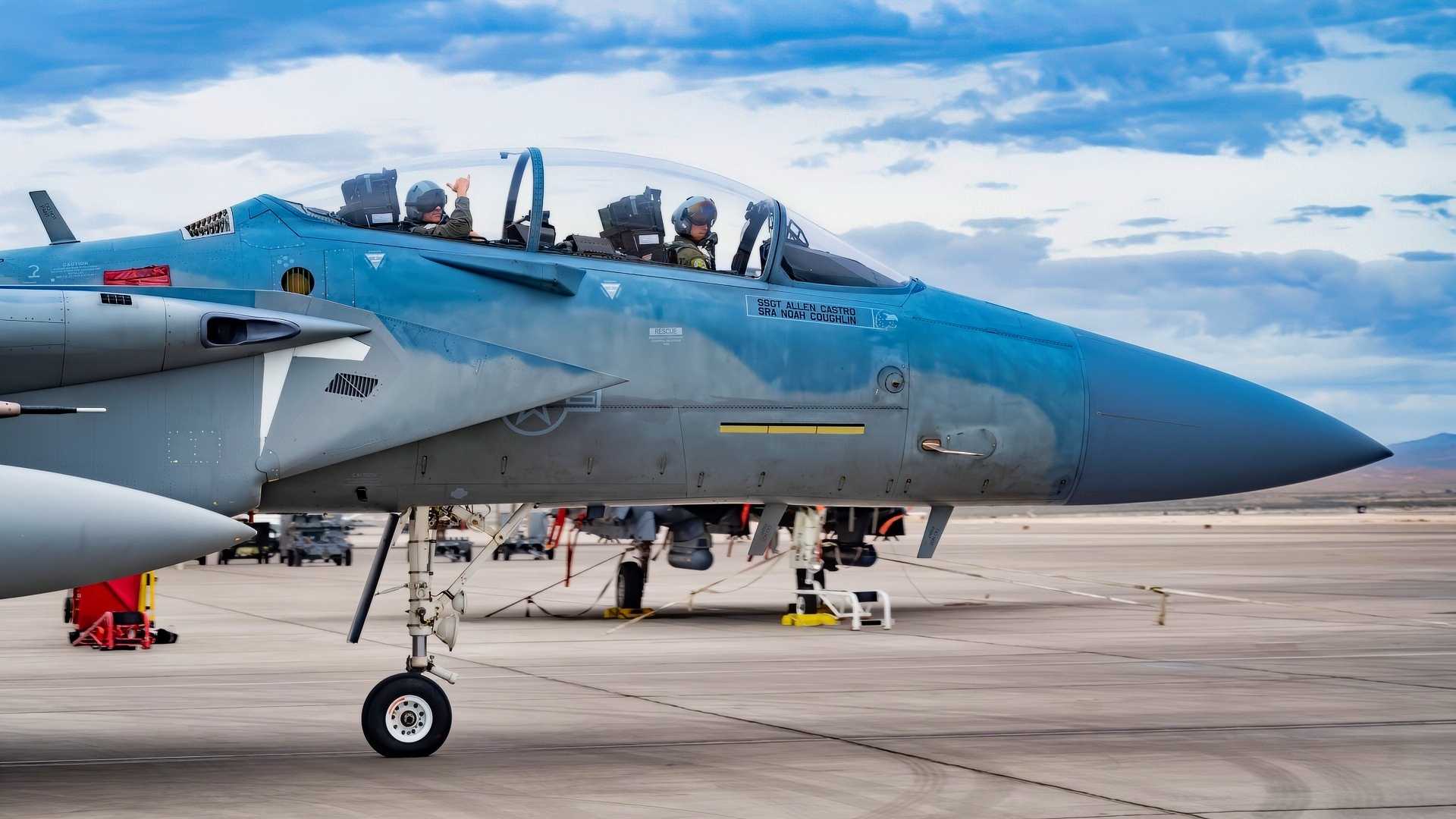Key Points and Summary – China’s J-35 is built to spot and shoot first, pairing a low-observable airframe, internal bays, and fused sensors for long-range ambushes.
-America’s F-15EX answers with raw speed, altitude, and a deep magazine, plus APG-82 AESA, IRST, and EPAWSS to survive initial shots and close.

A U.S. Air Force F-15EX Eagle II fighter jet assigned to Eglin Air Force Base, Florida, flies near Jacksonville, Florida, Nov. 2, 2024. Airmen from the 40th Flight Test Squadron and 96th Aircraft Maintenance Unit supported a flyover for the annual Florida-Georgia college football game. (U.S. Air Force photo by Staff Sgt. Blake Wiles)
-In BVR, stealth and networking tilt toward the J-35; miss the ambush and the Eagle II’s thrust-to-weight, energy maneuvering, and bigger WVR loadout take over.
-As always, the outcome rides on context: AWACS, jamming, numbers, pilot skill, and tactics—not hype—decide who wins on any given day. Geography, rules of engagement, and weather can swing results dramatically.
F-15EX vs. J-35A: Who Wins?
The F-15EX is the latest iteration of the venerable F-15 platform. It provides a comprehensive avionics upgrade and improves overall engine performance.
This ensures that the F-15 can hold its own in any mission environment, keeping the platform viable for decades to come.
But how would it fare against a fifth-generation enemy fighter jet?
The Shenyang J-35A is the newest fifth-generation stealth fighter, which is currently undergoing trials for the PLAAF and is expected to enter service in the coming years.
Can the F-15EX stand up to one of China’s top fighters, or does stealth already end the debate?
America and China’s Newest Fighters
The F-15EX is not a stealth aircraft. It retains the large radar cross-section of its predecessors, which makes it more visible to enemy radar.
However, it compensates for this with sheer power, speed, and payload. Capable of flying at speeds exceeding Mach 2.4 and carrying up to 22,000 pounds of ordnance, the F-15EX is a formidable platform for both air superiority and strike missions.
It is equipped with the AN/APG-82 AESA radar, an advanced infrared search and track (IRST) system, and the Eagle Passive/Active Warning Survivability System (EPAWSS), which provides robust electronic warfare capabilities. These systems enable the F-15EX to detect, track, and engage threats at extended ranges, even in contested environments.
The J-35A, on the other hand, is designed with stealth as a central feature. Its airframe incorporates radar-absorbent materials, internal weapons bays, and a shape optimized to reduce radar cross-section.

J-35A Fighter at Le Bourget Air Show. Image Credit: Author/National Security Journal.
These features give it a significant advantage in beyond-visual-range (BVR) combat, where the ability to detect and engage an opponent before being seen is crucial.
The J-35A is also equipped with advanced sensors, including a chin-mounted electro-optical targeting system and a modern radar suite, although the exact specifications remain classified.
Stealth: The J-35’s Trump Card
In terms of performance, the F-15EX outpaces the J-35A in several key areas. It flies faster, higher, and carries more weapons. Its combat radius is slightly shorter, but it can be extended with conformal fuel tanks and aerial refueling.
The J-35A, while slower and less capable in terms of raw payload, benefits from its stealth and agility. It is designed to operate from Chinese aircraft carriers, such as the Type 003 Fujian, and is expected to play a central role in China’s efforts to project power in the Indo-Pacific region.
The J-35A is a fifth-generation fighter designed with low observability in mind, featuring a stealth-optimized airframe, internal weapons bays, radar-absorbent materials, and diverterless supersonic inlets that reduce its radar cross-section.
These features allow it to operate undetected in contested environments and engage targets before being seen.
In contrast, the F-15EX, while equipped with advanced sensors and electronic warfare systems like IRST pods and EPAWSS, lacks stealth shaping and has a large radar signature due to its external weapons and legacy airframe design. As a result, the J-35A holds a clear advantage in scenarios where stealth is critical.
Does the F-15EX Stand a Chance?
The F-15EX is equipped with some of the most advanced systems in the U.S. inventory, including the AN/APG-82 AESA radar, the EPAWSS, which provides sophisticated electronic warfare capabilities. Its avionics suite is built around the Display Core Processor II, capable of processing vast amounts of data for real-time threat analysis and networked combat.
The J-35A, while less publicly documented, is believed to feature fifth-generation avionics including sensor fusion, a modern radar system, and an electro-optical targeting system similar to the F-35’s EOTS.
It likely includes AI-assisted threat detection and data-link capabilities for coordinated operations.
The F-15EX boasts superior raw engine performance compared to the J-35A, thanks to its two General Electric F110-GE-129 engines, each producing around 29,500 pounds of thrust. This gives the F-15EX exceptional speed, acceleration, and a high thrust-to-weight ratio, enabling it to reach speeds over Mach 2.4 and operate at altitudes above 65,000 feet.
In contrast, the J-35A is powered by twin WS-21 engines (or a similar variant), estimated to produce around 21,000 pounds of thrust each.
While sufficient for carrier operations and stealthy maneuvering, the J-35A’s engines do not match the F-15EX in terms of raw power or top-end speed, making the Eagle II the more dominant platform in terms of engine performance and high-energy maneuvering.
In 2 Words: Stealth Wins?
When comparing the two in a head-to-head fight, the outcome depends heavily on the context of the engagement.
In a BVR scenario, the J-35A’s stealth could allow it to detect and target the F-15EX before being seen. If it can launch long-range missiles like the PL-15E and disengage quickly, it might neutralize the threat without ever entering visual range.
The F-15EX, however, is not defenseless in this scenario. Its IRST system can detect stealth aircraft based on heat signatures, and its electronic warfare suite can jam or spoof incoming threats. If the F-15EX survives the initial engagement and closes the distance, it gains the upper hand.
In a within-visual-range (WVR) dogfight, the F-15EX’s superior thrust-to-weight ratio, maneuverability, and missile loadout give it a clear advantage.
It can out-turn and out-climb the J-35A, and its ability to carry a larger number of short-range missiles increases its lethality. The J-35A, while agile, is optimized for stealth and may not match the F-15EX in a close-quarters fight.
About the Author: Isaac Seitz
Isaac Seitz, a Defense Columnist, graduated from Patrick Henry College’s Strategic Intelligence and National Security program. He has also studied Russian at Middlebury Language Schools and has worked as an intelligence Analyst in the private sector.
More Military
The Massive B-36J Bomber Has a Message for the U.S. Air Force
Russia’s Su-47 Fighter: Moscow Only Made 1 For Good Reason
B-52J vs. B-21 Raider: The Air Force Might Have a Bomber Problem











Neo
September 12, 2025 at 12:13 am
The F-15EX would beat the J-35A on every level — it flies faster, higher, and carries more weapons. Its only drawback is a minor one: it can’t see the J-35A coming and might not even realize the 35A is nearby until it’s already locked onto by a missile. Still, this shortcoming is hardly worth mentioning.
Zach
September 12, 2025 at 10:17 am
Kinda weird premise, while the USA is gaining air superiority in a possible conflict China the F-15 will be a missile truck for the F-35s and F-22s. At the current time the F-35 can fire standoff missiles from a following F-15. I say all that to say a BVR fight will be against the sensors from an American 5th Gen platform. The missile may be fired from the 4th Gen platform but thats kind of irrelevant to the actual US usage
Marco
September 13, 2025 at 2:00 pm
Forget the plane—
I’ll take American pilots over Chinese pilots everyday
Bob Yadzinski
September 13, 2025 at 7:43 pm
I dispute the quality of all of China’s So Called Fifth Generation Fighters.
The Indian Air Force has tracked many
of the Chinese 5th Gen fighters on
their 4th generation radar.
Also Chinese 5th generation fighters
purposely stay away from South Korean, Japanese and USA aircraft so
their True Stealth capabilities will
not be revealed.